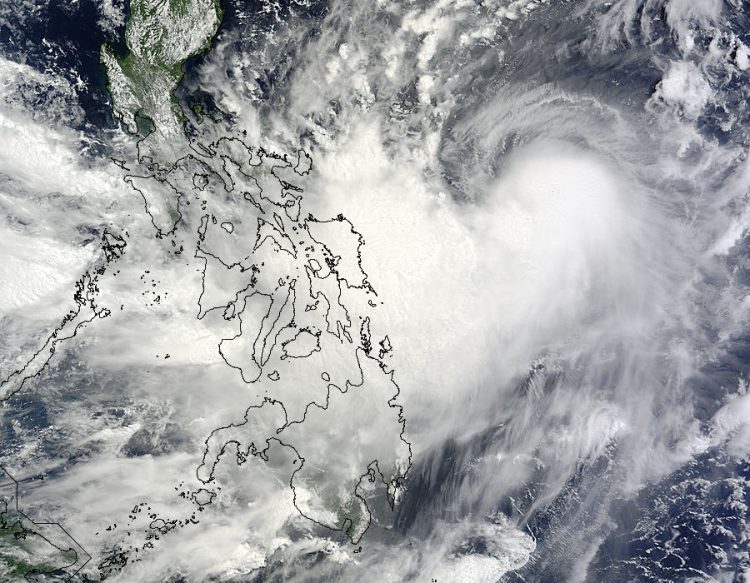NASA Satellite Sees Typhoon Matmo Brush Eastern Philippines

NASA's Terra satellite captured this image of Typhoon Matmo just east of the Philippines on July 20 at 02:15 UTC. Image Credit: NASA Goddard MODIS Rapid Response Team
NASA's Terra satellite passed over Typhoon Matmo on July 20 at 02:15 UTC and the Moderate Resolution Imaging Spectroradiometer or MODIS instrument aboard captured a visible image of the storm.
The MODIS image showed a thick band of thunderstorms west of the storm's center were sweeping over the eastern Philippines.
The Joint Typhoon Warning Center (JTWC) noted that animated multispectral satellite imagery on July 21 showed that convection (rising air that forms thunderstorms) around the center of circulation had strengthened from the previous day.
That stronger convection was evident in a thick band of thunderstorms in the southern quadrant of the storm that wrapped into the center. That same thick band of thunderstorms was also visible on the MODIS image of July 20.
On July 21 at 1500 UTC (11 a.m. EDT) Typhoon Matmo's maximum sustained winds were near 70 knots (80.5 mph/129.6 kph). Matmo was centered near 18.9 north latitude and 125.0 east longitude, about 500 nautical miles south-southwest of Kadena Air Base, Okinawa, Japan.
Matmo is moving to the northwest at 11 knots (12.6 mph/20.3 kph) while intensifying. The Japan Meteorological Agency has issued a yellow alert advisory for Okinawa-honto Chiho that includes thunderstorms and high waves as Matmo draws nearer.
JTWC forecasters said that improving upper-level conditions and warm sea surface temperatures in the Philippine Sea are conducive for further intensification, and they expect Matmo's sustained winds to peak near 105 knots (120.8 mph/194.5 kph) sometime on July 23 as it approaches northern Taiwan.
Text credit: Rob Gutro
NASA's Goddard Space Flight Center
Media Contact
More Information:
http://www.nasa.gov/content/goddard/10w-northwest-pacific-ocean/All latest news from the category: Earth Sciences
Earth Sciences (also referred to as Geosciences), which deals with basic issues surrounding our planet, plays a vital role in the area of energy and raw materials supply.
Earth Sciences comprises subjects such as geology, geography, geological informatics, paleontology, mineralogy, petrography, crystallography, geophysics, geodesy, glaciology, cartography, photogrammetry, meteorology and seismology, early-warning systems, earthquake research and polar research.
Newest articles

Trotting robots reveal emergence of animal gait transitions
A four-legged robot trained with machine learning by EPFL researchers has learned to avoid falls by spontaneously switching between walking, trotting, and pronking – a milestone for roboticists as well…

Innovation promises to prevent power pole-top fires
Engineers in Australia have found a new way to make power-pole insulators resistant to fire and electrical sparking, promising to prevent dangerous pole-top fires and reduce blackouts. Pole-top fires pose…

Possible alternative to antibiotics produced by bacteria
Antibacterial substance from staphylococci discovered with new mechanism of action against natural competitors. Many bacteria produce substances to gain an advantage over competitors in their highly competitive natural environment. Researchers…





















